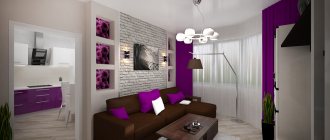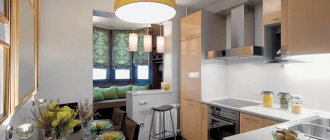Moving the kitchen into the living room
The kitchen is the soul of the Russian home. This includes relatives, friends and neighbors. Household members gather here many times a day: they eat, communicate, exchange news, make plans, celebrate holidays, and celebrate significant dates. If the kitchen space can no longer accommodate those who want it, it becomes important to move the kitchen to the living room or a more suitable place. This article highlights the issues surrounding this difficult event. Content links will help you quickly find answers to the most pressing questions.
Content
- Relocating a kitchen from the point of view of current legislation
- Using the space of a dismantled bathroom
- Placing a kitchen in a living room
- Problems with sewerage, ventilation, lighting when moving the kitchen into an apartment
- The main obstacles to obtaining permission (legalizing the transfer)
- Conclusion
Prohibited and allowed options
Cases when it cannot be transferred
- After the redevelopment, the kitchen space will be located directly under the bathroom of the neighbors above.
This option can work out if you increase the area of the new room due to the square meters of the bathroom by demolishing the partition.
There are exceptions here.
- This can be done if you have a two-story apartment.
- This can be done if you live on the top floor.
Kitchen moved to the living room along with communications
- After the redevelopment, under the new kitchen space there are living rooms for the neighbors.
There are exceptions here too.
- This can be done if you live on the first floor.
- This can be done if there is non-residential premises below you. As a rule, these are commercial premises on the first floors of apartment buildings. They can occupy one or two floors. With housing on the second or third floor, there is a chance to coordinate the project according to all the rules.
Kitchen in large living room. Water supply and sewerage are connected from the bathroom behind the adjacent wall
- The neighbors above the kitchen will have a toilet or bathroom.
It is good if the location of the new kitchen is close to the original location. Then it will be possible to avoid problems with the supply of sewerage, water supply and ventilation pipes.
- The kitchen is gasified.
It is impossible to remove the partition from the living room in a gasified room, because... According to the standards, it must be isolated. It is permissible to make sliding doors.
Exception: you can legally refuse gas in your apartment as a single person by submitting an application to the municipality. A special commission makes a decision on the reconstruction project and transition to a new tariff for electric stoves. After making changes to the technical plan, you can coordinate the time of work with gas services. The contract with old service providers is terminated and a new one is concluded with electricity suppliers.
- There will be access from the kitchen to the toilet or bathroom.
5 valid transfer options
Here are a few options when it’s realistic to get approval:
- you live on the first floor and there is no neighbors’ bathroom above you;
- on the floor below there is a non-residential premises;
- you have a two-level apartment;
- the neighbors below also legalized the redevelopment (and already under them (the neighbors) there is probably non-residential premises).
- you live on the top floor and are expanding the kitchen, combining it with a bathroom. There is an important note here: basic kitchen equipment (stove, sink, etc.) can only be located above non-residential premises.
Another possible example of redevelopment. Ventilation runs along the ceiling (hidden by a suspended or suspended ceiling), sewerage runs along the floor, and water pipes run next to the new sink.
Combining the bathroom and moving the kitchen into the living room.
It is easy to transfer communications here, because the wall borders the bathroom. But it can be difficult to coordinate the redevelopment of corridor partitions. There is another option, although it can hardly be called a transfer - demolishing the partition between the kitchen and living room. In Khrushchev buildings, this idea receives the most approval from the housing inspectorate, because the wall between the kitchen and living room is not load-bearing.
Relocating a kitchen from the point of view of current legislation
Many of those wondering whether it is possible to move the kitchen into the living room are captured by erroneous judgments. Some believe that such a change in layout is impossible, others - that the path to obtaining permission to move the kitchen is littered with insurmountable problems, and others - that in your own privatized housing (apartment, house) any alterations are allowed, as long as there is enough space. Still others are convinced that they will be able to retroactively legitimize everything that is arbitrarily altered and transferred.
The result is numerous violations, refusals to legalize redevelopment and fines, damaged equipment, frayed nerves, shed tears, lost time and wasted funds. The above troubles can be avoided. To do this, you need to know and take into account the attitude of the legislation to changing the configuration of living space. Let us immediately note that the law allows for the redevelopment of an apartment with the relocation of the kitchen. The mandatory conditions are:
- Preservation (not deterioration) of your own living conditions and neighbors after moving the kitchen;
- Following current sanitary (SanPiN 2.1.2.2645-10) and construction (SNiP 31-03-2003) standards and regulations;
- Compliance with the procedure for obtaining permission for redevelopment and agreeing to move the kitchen to a room or another place;
- Legalization of unauthorized modification of the layout in accordance with the prescribed procedure.
To be fair, we note a number of legal reasons for moving a kitchen to a new location. Permitting procedures will be simplified as much as possible when:
- The apartment to be rebuilt is on the ground floor (no one’s living conditions and interests are affected, you can safely do the redevelopment, based on building regulations);
- The reconstruction was started by the owner or tenant of a two-level housing (the interests, sanitary and living conditions of the neighbors below are not affected);
- The kitchen area is “relocated” above the corridors, storage rooms, and other non-residential premises located on the lower floors.
During renovation work related to the placement of a kitchen space in another area, it is necessary to solve typical problems in linking the actions performed with the existing requirements of regulatory documents. These include:
- Use of space vacated as a result of demolition (liquidation) of a bathroom;
- Transfer of the kitchen itself and kitchen equipment to the living room;
- Modification of sewerage and water supply;
- Ensure proper ventilation and natural light.
We will lay out subsequent material in the same order.
Communications
Moving the kitchen to a corridor or another room entails the need to provide a water supply to the sink and dishwasher, as well as drain household wastewater into the sewer system. For some reason, this is the last thing the owners think about, although it is this factor that very often becomes decisive when remodeling an apartment’s space.
There are practically no problems when installing water supply pipes. They can be placed either under the ceiling or in a screed under the floor covering, passed through small holes in the wall or walled up in grooves. Difficulties arise, as a rule, with the installation of sewerage, which must be laid at a certain slope, and the diameter of a typical pipe is larger than for a water supply, 50 mm, which often creates an obstacle when passing through load-bearing fences.
If the new location of the kitchen equipment is located at a great distance from the sewer riser, the difference from the wastewater intake to the entry into the riser will be significant. In this case, the system can be equipped with a pump.
When carrying out communications in the “new” kitchen area, one should not forget about ventilation, which rids the room of fumes and odors floating in the air during cooking. A properly laid box with a hood installed above the stove will protect the room from smoke and excessive humidity. It will definitely need to be connected to the exhaust ventilation duct located on one of the walls of the former kitchen, but in no case to the ventilation grilles located in the bathrooms. Otherwise, unpleasant odors will appear in the kitchen from time to time, if not constantly. When connecting the ventilation pipe to the duct, it must not be blocked or narrowed.
Installation of the ventilation duct is accompanied by some inconveniences:
- to ensure good traction, on long horizontal sections it will be necessary to install an additional fan and, as a result, a sound muffler;
- to improve visual perception, the pipe is hidden behind the suspended ceiling structure, which is not feasible even with a standard room height;
- To make it possible to lay the box without kinks, holes of significant diameter are punched in the walls.
When laying out communications to the new location of the kitchen, care should be taken to ensure that valves, connecting units and locking fittings remain freely accessible.
The relocation of the kitchen is also accompanied by the installation of electrical wiring. For the convenience of the housewife, it is necessary to provide lighting in the work area and the required number of sockets, as well as single lamps and lamps. Coziness and comfort will appear in the kitchen only if it has sufficient lighting, the brightness of which can be adjusted according to the situation and your mood.
There are many more nuances that owners encounter when moving a kitchen into a room than those previously listed. Before starting work, you should carefully consider all the difficulties that, with varying degrees of probability, may be encountered during the redevelopment process. With an irresponsible approach, the repair will stop somewhere in the middle stage, when it will not be possible to advance further due to various reasons, and it will be too late and pointless to go back.
Unfortunately, there are often situations in which the material resources spent on relocating a kitchen are not justified. Although there are also hopeless living conditions, when it is extremely difficult for a family to cope without remodeling the apartment.
Source: semidelov.ru
Using the space of a dismantled bathroom
By law, it is prohibited to move a kitchen to the site of a bathroom or bathroom that was liquidated for this purpose. The provisions of SanPiN 2.1.2.2645-10 (clause 3.8) and SNiP 31-03-2003 (clause 9.22) prohibit placing bathrooms above living rooms and kitchen areas. The only exception is two-level apartments. According to the law, by placing a kitchen on the “territory” of a former toilet, the owners are formally worsening living conditions.
Just five years ago, the problem was solved by contacting the competent authority with a statement about the awareness of such a step and the obligation to notify the buyer about this in the event of an apartment sale. Today, this loophole in the law has been closed. Exceptions are housing on two levels or living on the top floor, excluding the presence of bathrooms for neighbors above.
Application of design techniques when remodeling a one-room apartment
A chair-bed will help save useful space.
For example, in a partition dividing a large room into a living room and a bedroom, you can install stained glass windows that imitate an ordinary window closer to the ceiling, or use glass blocks. Such a wall will serve as an obstacle to noise penetration. In this case, natural daylight will pass into both fenced off rooms. The total area is sometimes divided by open or closed shelving, which determines the degree of isolation of the two created rooms from one another.
Related article: Budget bathroom renovation: photo examples
In the bedroom you can put a separate chair-bed or sofa, armchairs, computer, coffee table. You can put a closet in the hallway, add shelves for flowers or a rack for books. Provide storage space for children's toys. You can use plasterboard, plywood or chipboard as a decorative partition, which will allow you to turn a one-room apartment into a two-room apartment. You will need to make a frame from iron guides, which is then sheathed with a suitable material, and a layer of sound insulation is laid between the plasterboard slabs from the inside, installing a door or a system with sliding plasterboard partitions. In it, for example, at the top you can make a small narrow window across the entire width of the room near the ceiling. It is possible to install double-sided niches for storing books, saving space. Installing a narrow strip of glass blocks will be an interesting design solution that allows you to replace natural light with artificial light.
In order to make the countless old apartments more comfortable, designers have to contrive and invent how, taking the best from the layout, they can organize the place very well so that it is possible for an individual family to live comfortably, albeit in a small, but separate area.
Placing a kitchen in a living room
On January 26, 2006, the Government of the Russian Federation, by resolution No. 47 (see paragraph 22), clearly prohibited the transfer of the kitchen to the place where their own premises were located or under which residential premises were located on the lower floors. Having arbitrarily carried out such a redevelopment, the developer formally changed the status of the neighbor’s room below to “non-residential”. Such a legal conflict is unacceptable. But the law does not prohibit moving kitchen equipment to the corridor, former storage room or other non-residential premises. Placing an apartment on the ground floor or above non-residential areas also does not create restrictions for the plan.
Another unpleasant moment. If the mentioned redevelopment is successful, it will not be possible to arrange a children’s room, living room or bedroom in the vacant (former “kitchen”) space. According to the law, living rooms cannot be located under the kitchens of neighbors above. However, this situation has a legal solution. This is the design of these square meters as a work office. Legally, it will be non-residential, but it can be used at the discretion of the owner.
A few more nuances to consider:
- The newly equipped kitchen should receive natural light through an existing window or through a glass partition from the adjacent room;
- When arranging a kitchen-living room (studio), you will need to replace the gas stove with an electric one;
- Reluctance to switch from gas to electricity will result in the impossibility of making an opening from the kitchen to the living room in the partition between the rooms or the need to install a closing door (sliding partition) in it;
- When deciding to replace a stove (gas to electric), it is advisable to evaluate the increase in electricity bills.
Redevelopment of fully electrified apartments is much easier than gasified ones!
What are the disadvantages and advantages of remodeling a one-room apartment?
Studio apartments have become very popular lately, but they are not suitable for families with children.
As a result of combining a bedroom and a kitchen, one-room apartments often look like an ordinary warehouse for things that may sooner or later be needed on the household. By throwing out all the excess, including old furniture, you can get a place that you can properly dispose of and where you can sit quite comfortably even in a small living space. The downside is that it will not be possible to place any furniture in the room.
If you put in some effort, even a kitchen and a bedroom can completely “get along” together in one room. For example, during the day the space will be used for household purposes; in the evening it will often be vacated so that the kitchen can become a place for privacy and relaxation, why not take advantage of this opportunity? At the same time, the owner of a one-room apartment receives a spacious room, replacing two small ones, in which it is impossible to even turn around. The right choice of furniture and its convenient placement will allow you not only to live comfortably in the room, but also to receive guests, seating them comfortably to hold a home feast for the holiday, and later offer an overnight stay for those who need it.
In Russia, many furniture companies offer to buy inexpensive, cozy furniture, including custom-made furniture in specific sizes. This option opens up great opportunities, helping to save, arrange the space of the room at your own request, and carefully plan the use of each living meter in the apartment. When choosing one option for combining a kitchen and a bedroom in an apartment, you should prepare for all the inconveniences that will inevitably arise.
Firstly, a person will sleep near household appliances, that is, a refrigerator and a stove, and this will have to be tolerated. To minimize possible shortcomings and inconveniences, take special care: the kitchen will need to be arranged so that the noise produced by the appliances is minimal. Therefore, it is placed in the kitchen away from the sleeping area.
Article on the topic: Non-woven wallpaper for the nursery
A kitchen corner that transforms into a bed will free up space in the main room.
The set of a soft kitchen corner should include chairs, a table and a sofa, which can be transformed into a bed as needed. So you can also arrange a sleeping place in the kitchen. To give additional comfort, you can hang a sconce on the wall next to the soft kitchen sofa, or put a small cabinet that will act as bedside furniture. You can place, for example, flowers or souvenirs on the cabinet; you can store necessary things in it (a book, an alarm clock and other things).
Another method to transform your kitchen can be challenging. In this case, you may have to start actually creating the kitchen from scratch. Here it is necessary to use, if not the services of a specialist, then the advice of a master.
Problems with sewerage, ventilation, lighting when moving the kitchen into an apartment
Now let’s look at what moving a kitchen means for house communications.
A gas stove is an obstacle to a radical change in layout. When starting a redevelopment, it is advisable to replace the gas stove with an electric one!
Sewerage and water supply
The normal functioning of the kitchen involves ensuring the supply (transfer) of all types of household communications to a new location. Building codes require that the water supply to the dishwasher and kitchen sink, as well as the disposal of used water, must be uninterrupted (unobstructed) and constant. To supply water, old cold and hot water supply pipes are extended (extended) or new ones are laid. Laying is carried out in four ways:
- Along the walls in fines;
- Under the screed;
- Under a suspended or suspended ceiling;
- In decorative wall boxes.
It is advisable to re-lay sewer pipes in old houses. This is more technologically advanced and makes it easy to eliminate the structural differences between cast iron and plastic pipes. In new buildings this problem is solved even easier. Laying under a screed, especially at a distance of more than 3-4 meters, is not possible without installing a special pump: in order for wastewater to drain naturally, it is necessary to ensure a pipe slope of 3-5 degrees (about 3 cm per 1 linear meter of sewerage).
Wiring
To ensure sufficient illumination of the working surface and dining area, the correct and safe functioning of kitchen household electrical appliances, electrical wiring should be carried out. It must match the power consumption.
Moving a kitchen without a well-thought-out wiring design (scheme), without a reasonable choice of the type, material and cross-section of current-carrying conductors is a dangerous undertaking. Improper wiring is the cause of most fires. Therefore, the design of the electrical wiring diagram and electrical installation work must be entrusted to qualified specialists. Unlike new buildings, when remodeling old houses, it is better to completely replace the electrical wiring rather than move it.
Ventilation
Those wondering “is it possible to move the kitchen?” must be aware that a new kitchen must be equipped with ventilation. In accordance with SNiP 31-3-2003 (clause 9.7), it is entrusted with the task of removing air with substances formed during the combustion of household gas. Ventilation:
- It is connected to the old (which existed before the apartment was renovated) sealed ventilation duct, which sometimes stretches through other rooms;
- It cannot intersect with the neighbors’ ventilation, nor with the one installed in the bathroom, nor connect to the latter.
The main obstacle to installing ventilation is hiding the duct. Ways to get around are suspended ceilings, decorative boxes, grooved walls (including load-bearing ones) with holes made in them. For the latter, you will need to obtain a permit. It is advisable to equip long ventilation ducts with exhaust fans. In older houses, it is sometimes necessary to clean the ventilation ducts. In new buildings there is no such problem.
Lighting
The newly equipped kitchen should have sufficient lighting. According to SNiP 05/23/2010, the lighting standard for a kitchen room is not less than 150 Lux. According to SaNPiN2.1.2.2645-10 and SP 54.13330.2016, natural light should enter it during the day. Possible paths:
- From the street through the existing window;
- Through a fiberglass door;
- From the adjacent room through a glass partition, a partition made of glass blocks.
If the kitchen is moved to one of the former residential premises, problems with wiring and natural lighting usually do not arise. The option of moving it to a non-residential premises may cause difficulties with lighting, which will not be difficult for the designers and architects of our Redevelopment Coordination Bureau “PereplanHome” to solve. At the end of the article, we will focus on barriers that can significantly complicate permitting procedures.
Transfer Features
Dining room in orange style
In addition to the strict rules that must be followed when planning a kitchen in another room, there are a number of features that should not be forgotten.
For example, you should immediately think about how to implement new communications that were not mandatory before, but the kitchen cannot exist without them. The first thing you need to think about is connecting the water. If the territory of non-residential premises is used, you need to think about electrical wiring and lighting.
Water supply and sewerage
Before moving the kitchen into the room, you need to take care of the water supply and sewerage. In this case, the location of the sink will necessarily change, so you will have to use additional pipes.
It is necessary immediately, before redevelopment, to prepare a plan for a new water supply system. It often turns out that to do this, you have to block the doorway with pipes. But, the water supply can be installed under the floor screed or above the suspended ceiling.
With sewerage it is more difficult - sewer pipes must be laid at a certain angle - 20-30 mm. per meter of length. If the distance to the riser is large, the slope may not allow the pipes to be laid in the floor screed.
In this case, the pipes are laid without a slope and water pumps are used to pump water out of the sink and direct it into the riser.
The price of such pumps is not so high; the device is installed under the sink.
Lighting
Lighting in the dining room
In addition to the fact that the kitchen room, according to SNiP, must have a source of natural light, it is also necessary to carry out electrical wiring. In the case of a simple transfer, a window is sufficient.
If the transfer is carried out to a non-residential premises in which there is no window, you will have to change the plan of the partitions or doorway.
There are two options to solve the problem:
- natural light from the window of another room
- glass partitions - the use of glass blocks or fiberglass doors through which natural light shines is allowed.
By looking at photos of finished redevelopment designs on our portal, you can visually understand how this process is carried out. But, you need to take into account that even if the apartment fully satisfies the described recommendations and conditions, VERY few people manage to obtain permission to move it.
The main obstacles to obtaining permission (legalizing the transfer)
Those who have at least once tried to obtain permission to move a kitchen, or have legalized the redevelopment when it has already been moved, know firsthand about the existence of bureaucratic obstacles. To move a kitchen into a room or other premises legally, you need to remember the following or probable:
- Deterioration of living conditions;
- Violation of the integrity of load-bearing walls;
- Unqualified intervention in electrical wiring;
- Improper modification of the water supply system;
- Unacceptable changes to the heating system;
- Miscalculations in ensuring temperature conditions.
If the housing is located above administrative buildings (shop, office, cafe, restaurant), you do not need to worry that it will be prohibited from redevelopment, since in this case the kitchen will have to be moved above non-residential premises!
Possibilities of association
Recently, solutions for demolishing partitions in the apartment and combining the kitchen and living room in one space have become increasingly popular. Here the owner needs to know that:
- it is not permitted to dismantle, even partially, load-bearing walls;
- it is possible to combine living rooms with a kitchen only if there is an electric stove in it;
- If you have gasified kitchen equipment, in place of the disassembled partition you will need to install sliding structures or protective shutters that replace the door.
It is worth noting that in older houses it is not always possible to replace a gas stove with an electric one due to low-power electrical wiring that does not allow for increased loads. Often, even after changing the wiring inside the apartment, the issue remains unresolved, since the common cables located in Khrushchev and Stalin buildings do not meet modern requirements. In addition, for consumers using electric stoves in gas-connected houses, discounts on electricity consumption are not provided. Therefore, the cost of paying for it will increase sharply.
Should it be legalized?
Yes. Any changes to the apartment must be agreed upon with the housing inspectorate , especially if you do not exclude the possibility that in the future you will want to exchange your square meters, sell them or pass them on by inheritance. No, it will be possible to sell it in half, but the illegally “remodeled” apartment will seriously lose in price .
If we are talking about a mortgage, then the banks in this case will answer with a categorical refusal . Regulatory authorities may not only not approve some options, but also impose a fine.
Then they will put forward an order to remove all the “handmade” and return the apartment to its original form, and in case of stubborn resistance, they will bring the matter to trial and the apartment will be put up for auction (such precedents have already been encountered). It is much easier to resolve the issue in advance . Fortunately, this is not so difficult to do. How to legalize redevelopment, read here.
Where can it not be transferred?
Under no circumstances can the catering unit be moved to the living room, bathroom, balcony or loggia.
You cannot combine the kitchen and the only living room into one whole - this is what Appendix 1 of Moscow Government Decree No. 508, ed. 840 (clauses 11.17 and 11.18). Thus, the apartment turns into non-residential premises, which is prohibited by law.
By the way, this rule applies not only to Khrushchev (kitchen remodeling), but in general to all apartments in all houses with gas stoves .
Moreover, there is Decree of the Government of the Russian Federation No. 47 of January 28, 2006, which prohibits installing a kitchen above the living quarters of neighbors living below you.
True, this prohibition can be circumvented in some way - since the law requires a tightly closing door between the kitchen and the room, residents install a sliding partition in the wall opening .









